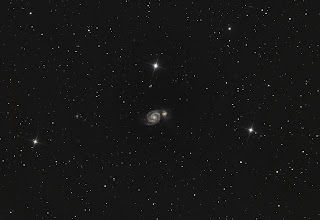NGC 6992 - Eastern Veil Nebula 'Network Nebula'.jpg)
Telescope: APM Astrograph 107, f/6.5 with Baader Steeltrack Focuser and 2.5'' TS FF
Mount: HEQ5 Pro
Camera: QHY8
Filter: IDAS LPS
Guidescope: Skywatcher 70/500mm
Guide with LVI SmartGuider
Exp. Time: 3hours, bin 1x1
Calibration Frames: 30 flat, 50 bias
Capture: Nebulosity 2.2.5
Stack: Nebulosity 2.2.5
Processing: Photoshop CS3
Date: 14 Jul 2010
Location: Tiros Arkadias, GR
NGC 6960 - Western Veil Nebula 'Witch's Broom Nebula'.jpg)
Telescope: APM Astrograph 107, f/6.5 with Baader Steeltrack Focuser and 2.5'' TS FF
Mount: HEQ5 Pro
Camera: QHY8
Filter: IDAS LPS
Guidescope: Skywatcher 70/500mm
Guide with LVI SmartGuider
Exp. Time: 3 hours & 40 mins, bin 1x1
Calibration Frames: 50 flat, 50 bias
Capture: Nebulosity 2.2.5
Stack: Nebulosity 2.2.5
Processing: Photoshop CS3
Date: 9 Jul 2010
Location: Parnon Mount, GR
The Veil Nebula, is part of the Cygnus Loop, radio source W78, or Sharpless 103. Other parts of the loop include the 'Eastern Veil', the 'Western Veil' or 'Witch's Broom Nebula', and Pickering's Triangular Wisp. It is a large, relatively faint supernova remnant in the constellation Cygnus. The source supernova exploded some 5,000 to 8,000 years ago, and the remnants have since expanded to cover an area of ~3x3 degrees; about 6 times the diameter or 36 times the area of a full moon.
The distance to the nebula is not precisely known, with estimates ranging from 1,400 to 2,600 light-years. It was discovered on 1784 September 5 by William Herschel. He described the western end of the nebula as "Extended; passes thro' 52 Cygni... near 2 degree in length." and described the eastern end as "Branching nebulosity... The following part divides into several streams uniting again towards the south."
The Hubble Space Telescope captured images of the nebula. The analysis of the emissions from the nebula indicate the presence of oxygen, sulfur, and hydrogen.
Veil Nebula Wiki






.png)
+in+Ha.png)
.jpg)
.jpg)
.jpg)
+(2).jpg)
.jpg)
.jpg)
.jpg)
.jpg)
.jpg)

.jpg)
.jpg)
.jpg)